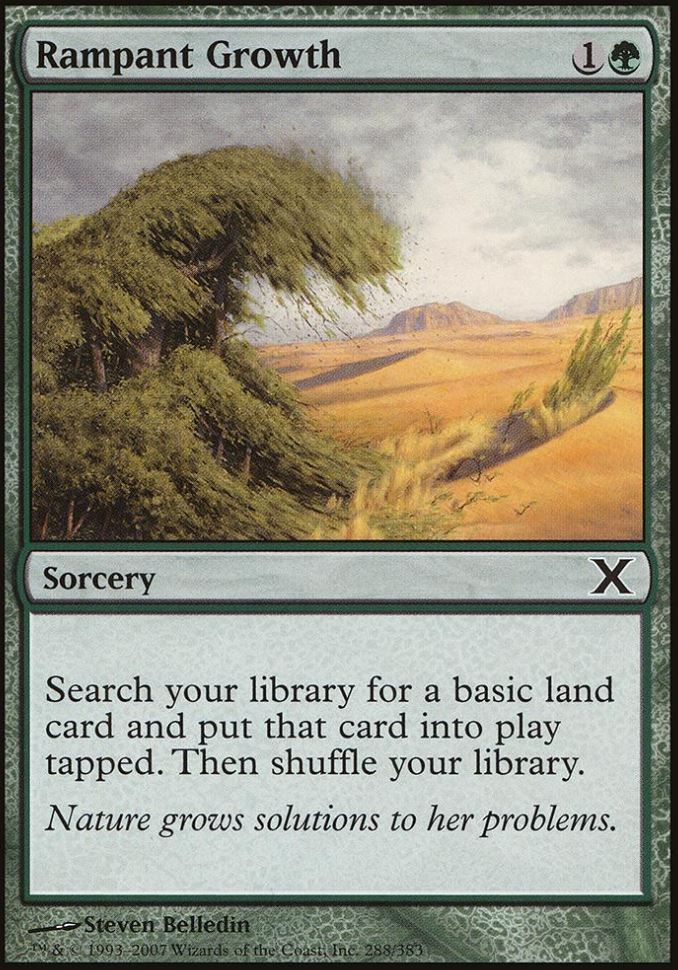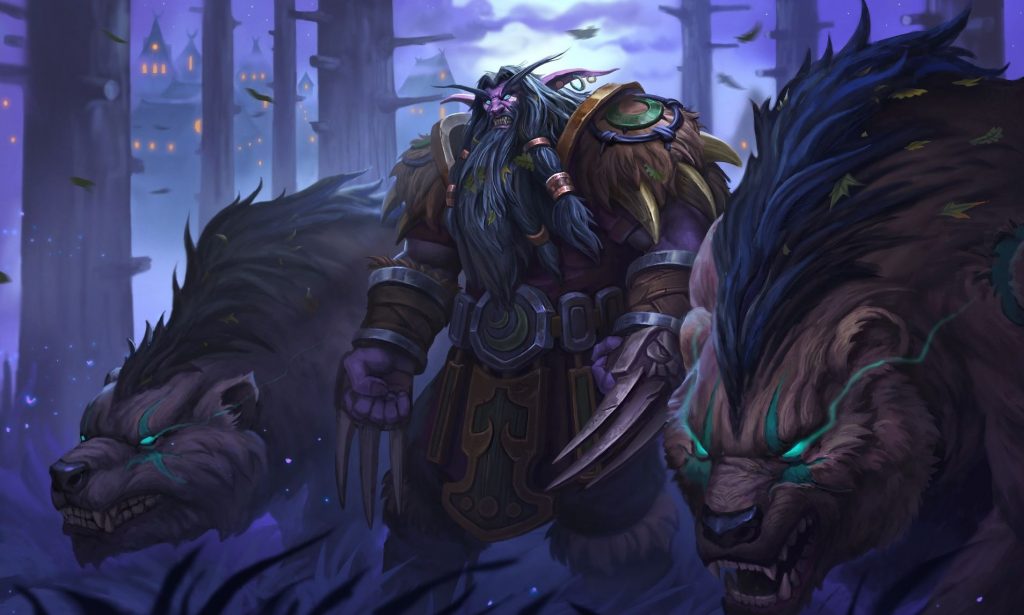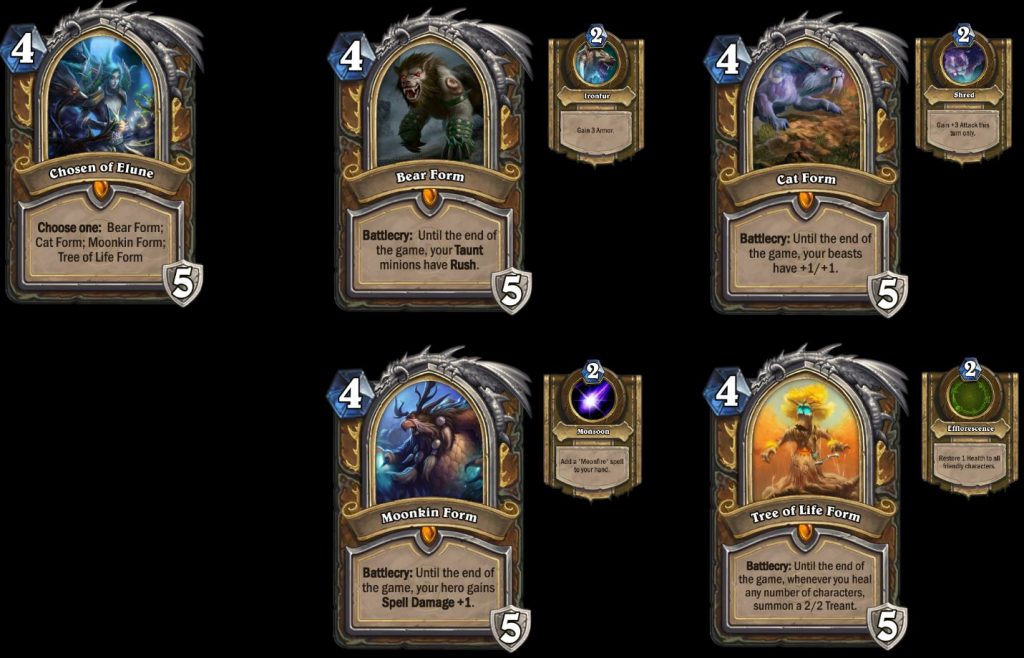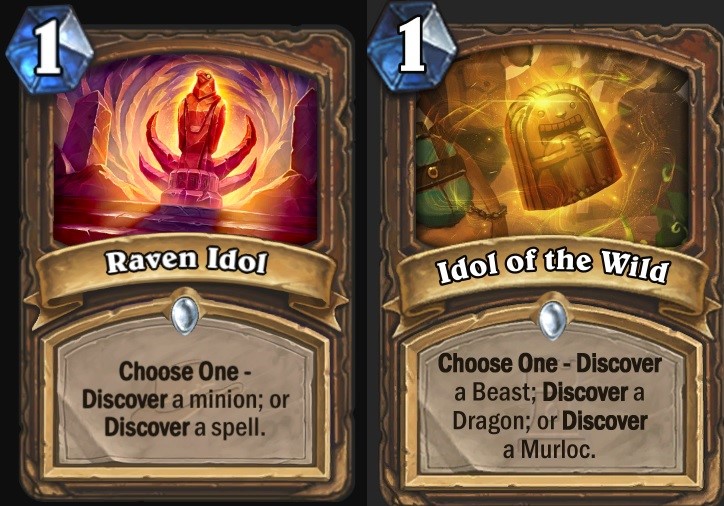If someone asked me which Hearthstone class had the most realistic and worldly approach in terms of general feel and fantasy, I’d probably take Druid as the first pick. The “hippie” mentality of safeguarding nature from all evil is something that is widespread in these troubling times more than anything, really, and one doesn’t need to know anything about actual druidry to develop a meaningful relationship to “mother Earth”.
Druids in the Warcraft universe cater to this worldly fantasy while applying their own principles to define their class identity, such as shape shifting or extensive support towards themselves and their allies. In this third edition of our Class Identities series, we take a look at the development of the Druid class and how it came to be – from blue dragons jumping over the biggest ramps over large green men to summoning big beasts.
The Past of Druid
Looking at Druid’s core Basic and Classic sets, one thing becomes very clear, especially for die-hard Blizzard fans: The core Warcraft Druid identity revolves a lot around the night elf culture. Anybody who played a decent amount of Warcraft III, the game that defined the lore surroundings for upcoming games like World of Warcraft and Hearthstone, reads Druid’s Hearthstone card and gets taken back to playing the Night Elf race in Blizzard’s fantasy RTS – maybe it be night elven structures such as Ancient of Lore or Ancient of War or units such as Druid of the Claw and Keeper of the Grove.
Even Warcraft III spells like Force of Nature and Savage Roar found their place in Druid’s toolkit – but it was one major and “card game exclusive” mechanic that really defined the Druid class in Hearthstone from the get-go: Ramp.
What was once a gameplay mechanic in the mother of all collectible card games called Magic had to find its way into Hearthstone as well. Ramping, derived from a Magic card called Rampant Growth – a spell that added a land resource to your board when played – dictated the gameplay of the majority of successful Druid cards.

And coming from a Druid fantasy point of view, it really did fit. Wild Growth, Nourish and Innervate transported the feeling of a peaceful combat approach, which rewards the Druid through the power of patience and nature’s bond. However, Hearthstone in itself is a volatile design space, and the theory of a class core being designed around ramping up a resource called mana surely sounds like a balancing challenge – and it is up to this day.
In the end, Druid things started to go downhill when Mean Streets of Gadgetzan, Hearthstone’s fourth expansion, got released. The set introduced the Jade mechanic, which in itself served as yet another ramp mechanic involving Jade Golems, nameless minions which spawned larger and larger versions of themselves every time you played a Jade synergy card.
Needless to say, Druid players gladly took what they got offered, and Jade Druid became one of the most dominant archetypes in Hearthstone history. The combination of ramping resources and minion strength at the same time put every other list behind, especially when it came to late game prowess.
In retrospect, the Jade Druid situation set the precedent for many, many Druid archetypes that followed: Druid never really cared about its identity, its heritage of controlling the powers of nature, and never tried to weave its identity around certain archetypes. And why? Because the class always used some sort of outlandish yet powerful win condition that abused a confusing mix of Druid cards – all showcased perfectly through a card that we all know and love or hate: Malygos.
Malygos Druid brought OTK decks to another level, and made Druid the most hated class by a mile, especially in its most powerful iteration during Knights of the Frozen Throne.
And even just a quick look at the rest of the list does not only take you back to the times of absolute Druid domination – it also underlines the fact that Druid’s core identity was still of secondary importance in comparison to the power level of a given archetype. How else could outlandish cards like Spreading Plague and Ultimate Infestation, two spells that rely on the total opposite what Druids in Warcraft stand for, become successful in the first place? And while those cards were made to fit the general theme of an expansion revolving around the death-knight counterparts of Hearthstone’s classes, one couldn’t help but just shrug when asked about the identity of Druid back in the day.
The Present of Druid
It’s safe to say that a majority within the community would want Malygos to rotate out of Standard. Many Druid archetypes built around spells will always try to abuse the unlimited powers of the Aspect of the blue dragonflight and thus limit itself in the usage of much-needed design space.
And besides the fact that cards like Forest Warden Omu are still designed, there is yet hope for Druid’s class fantasy. In the current meta, a deck called Guardian Druid encourages spell-heavy gameplay that relies on mana cheating and ridiculous swing turns in the early and mid game – and all that without Malygos!
The connection between Druids and animals is obvious: Both bound to the power of nature, they need to work together to defeat what brings evil to Azeroth. The core card of the archetype, Guardian Animals doubles down on that fantasy – while still transporting the “highschool” theme of Scholomance Academy, as seen in its card art.

With beasts like Twilight Runner, Teacher's Pet and Lake Thresher, Guardian Druid adapts to the wildlife at hand, and is able to choose their companions based on upcoming beast additions with future sets.
Another interesting card on second sight is Ironbark: In World of Warcraft, Ironbark is one of the most powerful Druid abilities, shielding enemies from incoming damage.
In Hearthstone, the card plays with the newly introduced mana cost bonus based on current mana, a great reward structure as a Druid mechanic that ties into the existing identity to rely on ramping. What’s wild though is that the card art itself shows the sporelings of Zangarmarsh defending themselves, and that brings the card in line with the Ashes of Outland expansion lore, while still applying its crucial Warcraft theme through the card text.
Hearthstone-exclusive spells like Overgrowth, Overflow and Survival of the Fittest perfectly tie into this general theme of transporting expansion flavor while representing the “original” Druid philosophy – in this case supporting and buffing their allies while playing around resource optimization.
Yes, we still have to endure including build-supporting cards like Animated Broomstick or Kael'thas Sunstrider that don’t line up with Druid’s general identity, but it looks like Druid is on its way to establish a proper class identity.
The Future of Druid
It’s surprisingly hard to come up with ideas for future concepts that could empower Druid’s class fantasy; one of the major reasons for that is the fact that this class basically defines the “jack of all trades – master of none” RPG archetype.
Similar to Paladins, Druids in World of Warcraft nowadays can take all three roles of the “holy trinity” of modern-day MMOs. What many players love about this is not only the fact that they’re versatile depending on different in-game situations – thanks to the Druid’s power to shapeshift, they also see and feel the difference in playing different roles.
Team 5 already tried to include this flavor of “identifying choice” with the “Choose” keyword and all its variations. However, it’s mostly printed with minion cards or spells. Malfurion the Pestilent was a great exception to the rule, and while its design was pretty damn powerful, we could see a shapeshifting “Choose one” Druid hero as a great way to introduce meaningful choice based on core class fantasy. I mean, who doesn’t want to get the choice between becoming a laser-shooting super-owl or a life-giving, treant-spamming tree?!

Another cool idea could be the implementation of Idols. It’s safe to say that Raven Idol is still one of the coolest and best-designed Druid cards, and creating similar cards based around Druid’s core values could have the same effect that we see with Librams, the Paladin equivalent to idols, which in World of Warcraft could be placed into a special “Relic” slot to empower certain class-exclusive abilities.

All in all, and compared to our two existing class identity reports about Paladin and Warlock, Druid still has a long way to go but starts to feel a lot more like a protector of the wild of Warcraft. If Team 5 decides to go back to the ancient roots of Hearthstone’s druidry, we might receive Druid cards that further transport the complex Druid identity which is based on a meaningful choice around protecting yourself, your allies, and the Earthmother itself!

Hearthstone was fun with Malfurion the P. Kinda sucks lately.
I’m enjoying these articles, thanks for writing them.
I had always felt like Warlock was a bit off, because (apparently until recently) their unique strategies (discarding your cards, damaging yourself) never seemed to be very effective, And Big Demons, I don’t, has ever worked since Bloodreaver Gul’Dan and his Carnivorous cubes.
I had a friend I was trying to persuade a friend to start playing hearthstone, circa Boomsday Project. And I remember saying that Druids seem to be able to do anything. So she might try to swarm you down by playing loads of tokens and then playing savage roar. Or be cheating with mana to pull off one of various OTK combos. Or they might playing really big minions. So they felt really all over the place for a while, it feels like they’re a bit more stable now.
I’m trying to stay away from actual WoW class design as much as possible, because in the end we’re talking about Hearthstone here – but the problem of “being all over the place” mostly applies to multi-role classes like Paladin and Druid. Their core fantasy includes healing, damaging, and defensive spells/minions, so from Hearthstone’s release, they were able to play vastly different archetypes.